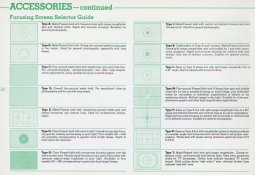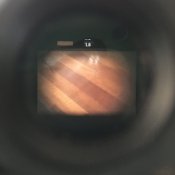INCORRECT: Nikon F3 Screen U does not have a micro prism dot, only a smooth matte surface, with an almost imperceptible extra fine area in the center. I've used the U screen often with many long Nikkors and it is my preferred screen for use with my 400mm f/2.8 especially when used with converters. With the TC-301 on the 400mm the U screen with NO micro prism spot remains bright (ish) while the F3's standard K screen blacks out the center, as does the J screen (which is my standard screen for both F4 and F3 unless I plan on shooting the 400mm exclusively). I've also effectively used the H series screens for low light long lens work, of course matching the H Series to the lens.
As for the 135mm DC, the K screen should work as normal; I use K, J, U and H2 with my Nikkor 135mm f/2 Ai-s without any issue or blackout.
The Red Dot screens were an improvement in the etching of the matte surface being made with the help of lasers, a technology I think introduced by Minolta and used in Hasselblad screens. The introduction of the Nikon F4 included the same screens and the Red Dot (as well as a black dot on the original Nikon packaging box) indicates the newer versions for the F3.
I have compared K, B, J and U screens for F3 with Red dot and without and the Red Dot versions are *slightly* "brighter" but have a touch less contrast (snap to some people) and the fineness of the matte surface is the most noticeable. The non red dot is like 120 grit sand paper and the red dot versions are like 320 grit. Side by side comparisons using two F3 bodies shows these differences, in practice the non red dot screens are perfectly useable. I did prefer the R screen non red dot for using the 40mm with the TC-301 and the TC-14b (and E) stacked together, while the center rangefinder spot did black out the coarser grain of the matte surface non red dot made the focus much more apparent. I've never found a red dot R screen.
I will repeat this for anyone who hasn't seen the many posts I've made on the topic; don't install an F4 screen into an F3 they may fit but they are not interchangeable and you will introduce focussing errors. If you want a brighter screen in an F3 get a red dot version it will be the same as an F4 screen but in correct registration. However, F3 screens can be used correctly on an F2 without any problem, you'll just need to install into the F2 with the screen lip reversed. In this case the F2 gets a very much noticeable improvement but you will need to make a slight exposure compensation since the meter reads from the screen. I suppose there are a few people still shooting F2's using the camera meter, the only F2 meter I trust is one that Sover Wong did a CLA many years ago.









